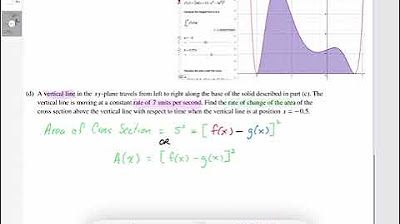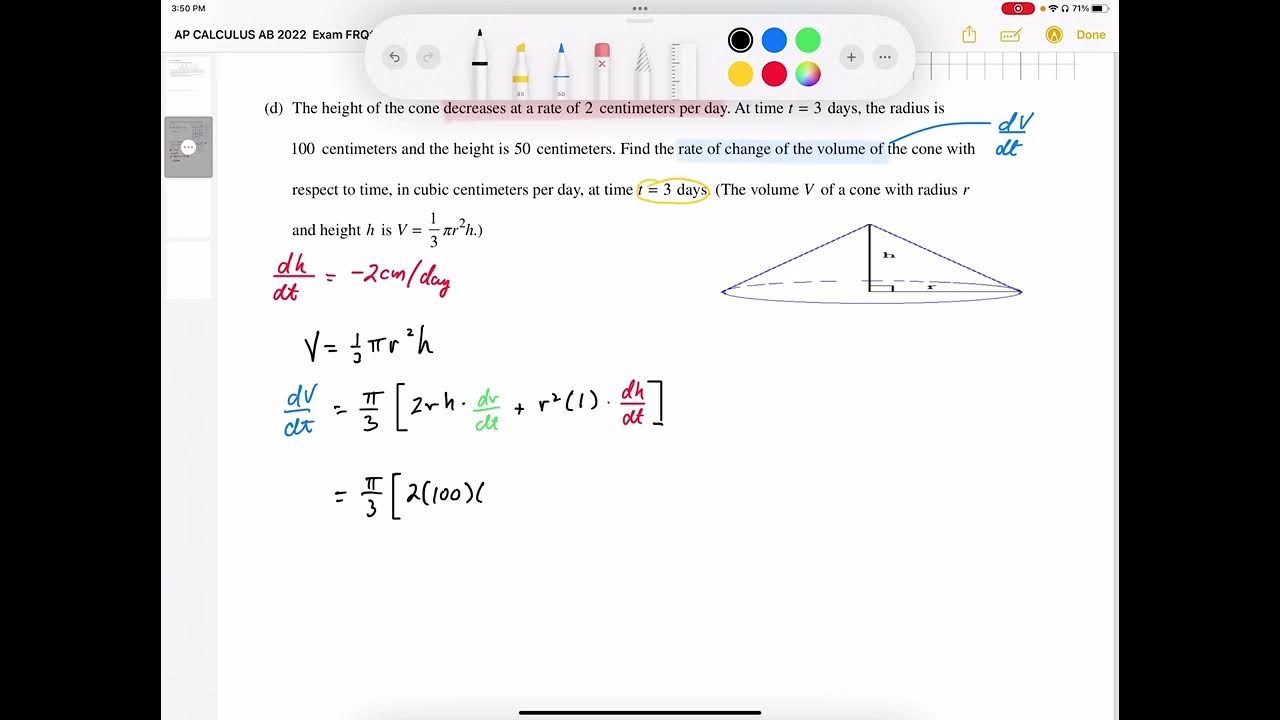Related Rate Problem #4 - Change in Consumer Demand
TLDRThe video script presents a related rate problem involving a customer's disposable income and its impact on the quantity of premium coffee purchased. The customer has a fixed disposable income of $30,000, which is increasing at a rate of $7,000 per year. Using a demand equation q = 27.28 * log(x) - 76.61, where x represents disposable income, the initial quantity of coffee purchased annually (q) is calculated to be approximately 204.62 cups, which can be rounded to 205 cups. To find the rate of change in the number of cups purchased (dq/dt), the derivative of the demand equation with respect to time is taken, resulting in dq/dt = 27.28 * (1/x) * (dx/dt). Substituting the known values yields dq/dt = 6.37 cups per year, indicating that the customer's coffee consumption is increasing at this rate.
Takeaways
- 💼 The customer has a fixed disposable income of $30,000, which is represented by the variable x.
- 📈 The disposable income is increasing at a rate of $7,000 per year, which is denoted by dx/dt.
- ☕ The objective is to determine the annual quantity of premium blend coffee (q) the customer will purchase.
- 🔍 The demand equation given is q = 27.28 * log(x) - 76.61, which relates the quantity of coffee to disposable income.
- 🧮 Initially, q is calculated as 27.28 * log(30,000) - 76.61, which equals approximately 204.62 cups of coffee.
- 📊 The number of cups of coffee (q) is typically rounded to the nearest whole number for practical purposes, which is 205 cups.
- 🤔 The rate of change of the number of cups of coffee purchased per year (dq/dt) is sought.
- 🌟 To find dq/dt, the derivative of the demand equation with respect to time is taken, resulting in dq/dt = 27.28 * (1/x) * dx/dt.
- ⏱ Plugging in the values, dq/dt is calculated as 27.28 * (1/30,000) * 7,000, which equals 6.37 cups per year.
- 🚀 The customer's annual consumption of premium blend coffee increases at a rate of 6.37 cups per year.
- 📝 The final answers to the problem are the quantity of coffee purchased annually (q) and its rate of increase (dq/dt).
Q & A
What does 'dx/dt' represent in the context of this related rates problem?
-In the context of this problem, 'dx/dt' represents the rate of change of disposable income with respect to time, which is given as $7,000 per year.
What is the significance of the equation 'q = 27.28 log(x) - 76.61' in the problem?
-This equation is the demand equation given in the problem, which models how the quantity of premium blend coffee purchased (q) varies as a function of the customer's disposable income (x).
How is the quantity of coffee purchased (q) calculated for a disposable income of $30,000?
-To calculate q, plug $30,000 into the demand equation: q = 27.28 * log(30,000) - 76.61. This calculation results in approximately 204.62 cups of coffee.
Why might you round the value of q to 205 cups of coffee?
-Since q represents the number of cups of coffee, a fractional number doesn't make practical sense for actual purchase. Therefore, rounding to 205 cups simplifies for practical purposes, assuming you deal with whole units.
How do you calculate the rate of change of the quantity of coffee purchased per year, dq/dt?
-The rate of change dq/dt is calculated using the derivative of the demand equation. It involves the derivative of the logarithm function applied to x, multiplied by dx/dt, and simplifies to 27.28 * (1/30,000) * 7,000.
What does the result of 6.37 in the calculation of dq/dt signify?
-The result of 6.37 indicates that the number of cups of premium blend coffee purchased is increasing at a rate of 6.37 cups per year.
What mathematical concept is used to find the derivative of the demand equation in this problem?
-The mathematical concept used is the chain rule, which is applied to find the derivative of the logarithmic function of x, taking into account the rate of change of x with respect to time.
Why is the value of x fixed at 30,000 in the problem?
-In the problem, x is initially fixed at 30,000 to represent the current disposable income of the customer. It allows for the calculation of the current quantity of coffee purchased before considering how changes in income affect this quantity.
What practical implications does the demand equation have for predicting consumer behavior?
-The demand equation allows businesses to model and predict how changes in consumer disposable income could affect the demand for their products, in this case, premium blend coffee.
How would the rate of change in the quantity of coffee purchased affect business planning and inventory management?
-Understanding the rate of change helps businesses plan for future demand fluctuations, ensuring adequate inventory management and optimizing ordering schedules to meet customer needs without overstocking.
Outlines
📈 Solving a Related Rates Problem in Economics
The script presents a related rates problem involving disposable income and the purchase of premium coffee. Initially, it sets the disposable income 'x' at $30,000, increasing at $7,000 annually (dx/dt = 7,000). The problem requires determining the annual quantity of premium coffee (q) purchased using the demand equation q = 27.28 * log(x) - 76.61. The direct calculation of q from the given income results in 204.62 cups, suggested to round off to 205 cups if needed. Subsequently, the script explains the process of finding the rate of change in the quantity of coffee purchased per year (dq/dt) using the derivative of the demand equation, resulting in a change of 6.37 cups per year.
Mindmap
Keywords
💡Related Rate Problem
💡Disposable Income
💡dx/dt
💡Demand Equation
💡Logarithm
💡dq/dt
💡Derivative
💡Premium Blend Coffee
💡Rate of Change
💡Rounding
Highlights
The customer has a fixed disposable income of $30,000.
Disposable income is increasing at a rate of $7,000 per year.
The demand equation for premium blend coffee is given by q = 27.28 * log(x) - 76.61.
The initial quantity of coffee purchased annually (q) is calculated to be 204.62 cups.
It is suggested to round the quantity of coffee to the nearest whole number, which is 205 cups.
The rate of change of the quantity of coffee purchased annually with respect to time (dq/dt) is required.
The derivative of the demand equation with respect to time is calculated to find dq/dt.
The derivative of log(x) with respect to x is 1/x.
The rate of change of disposable income with respect to time (dx/dt) is given as $7,000.
The final calculated rate of change of coffee cups purchased (dq/dt) is 6.37 cups per year.
The customer's disposable income and coffee purchasing behavior are directly related.
The mathematical model helps predict the customer's future coffee purchasing based on income growth.
The problem involves the application of related rate calculus in a real-world economic scenario.
The solution requires understanding the relationship between disposable income and demand for a product.
The problem-solving approach involves substituting known values into the demand equation.
The use of logarithmic functions in the demand equation reflects a non-linear relationship between income and demand.
The rate of change of disposable income is a key factor in determining the rate of change in coffee consumption.
The solution demonstrates the practical application of calculus in predicting consumer behavior.
The problem illustrates the importance of mathematical modeling in economic forecasting.
Transcripts
Browse More Related Video

Related Rate Problem #5: Cobbs-Douglas Production Function

Related rates of volume and area of a cube

AP CALCULUS AB 2022 Exam Full Solution FRQ#2d

AP CALCULUS AB 2022 Exam Full Solution FRQ#4d

Learn how to find the change in theta for a triangle, related rates

Related Rate Problem #1 - Change in Tuition
5.0 / 5 (0 votes)
Thanks for rating: